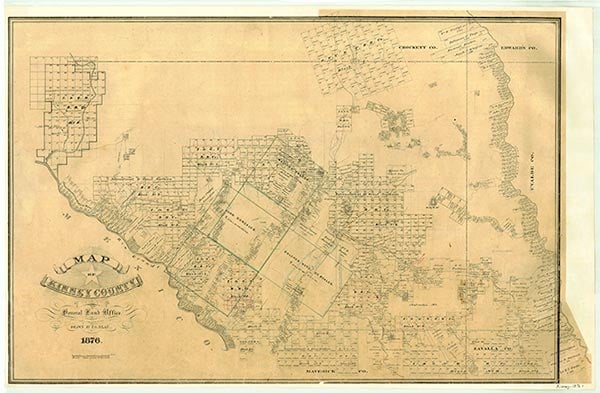Fort Clark

Fort Clark was established on June 20, 1852, at Las Moras Springs in Kinney County by companies C and E of the First Infantry under the command of Maj. Joseph H. LaMotte. The name Las Moras ("the mulberries") was given by Spanish explorers to the springs and the creek they feed. The site was long favored by Coahuiltecan Indians and later by the Comanches, Apaches, and other tribes. During the late eighteenth and early nineteenth centuries the big spring was a stopping place on the eastern branch of the great Comanche Trail into Mexico. In 1849 Lt. W. H. C. Whiting, during his reconnaissance for a practicable wagon route between San Antonio and El Paso, recognized its military potential and recommended the location as a site for a fort. The post was originally named Fort Riley in honor of the commanding officer of the First Infantry, but on July 15, 1852, at Riley's request, it was renamed in honor of Maj. John B. Clark, a deceased officer who had served in the Mexican War. A formal military lease for Fort Clark was made on July 30, 1852, when Lt. Col. D. C. Tompkins signed an agreement with Samuel A. Maverick, who owned the land, for a period not to exceed twenty years. The fort was strategically located as anchor to the cordon of army posts that had been established along the southwest Texas border after the Mexican War. The fort's purpose was to guard the Mexican border, to protect the military road to El Paso, and to defend against Indian depredations arising from either side of the Rio Grande. By November 1852 Fort Clark had two companies of the First Infantry under the command of Capt. W. E. Prince, and for the next three years officers of the First Infantry and Mounted Rifles served as post commanders.
Bvt. Lt. Col. W. G. Freeman inspected Fort Clark on August 1, 1853, as a part of his tour of the Eighth Military Department, and reported it to be "a point of primary importance...from its salient position looking both to the Rio Grande and Indian frontiers." Freeman was the first to recommend the fort as being "well fitted for a Cavalry station." The quartermaster, according to Freeman, had only eight wagons available for hauling the materials needed to build the post. This was an inadequate number since the depot at Corpus Christi was 280 miles distant and wagons required thirty days, under favorable conditions, to make the round trip. Mail came to the post from San Antonio, "being brought weekly by special express." From their campsite near the spring and from tents pitched along the banks of Las Moras Creek, soldiers began construction of the fort on an adjacent high limestone ridge. The first barracks and houses were Mexican-type jacals and crude log huts of palisade construction. A few buildings of limestone, some of which are still standing, were begun in 1856–57. The ruins of the old post headquarters building has the date 1857 over the doorway. With the establishment of Fort Clark, a neighboring settlement of Las Moras came into existence when Oscar B. Brackett established a supply village for the fort. The town's name was changed to Brackett in 1856 and later to Brackettville. The stage from San Antonio to El Paso ran through the settlement, and for almost a century the town and the fort remained closely identified. In the summer of 1854 the Indian menace in Texas prompted Gen. Persifor F. Smith, the department commander, to make a requisition to Governor Elisha M. Pease for six companies of Texas Rangers to conduct a campaign against the raiders. Two companies of these Texas military volunteers, under captains Charles E. Travis and William Henry, were sent to Fort Clark, where they assisted the regulars in patrolling the road. Col. J. K. F. Mansfield inspected the post in early June 1856 and reported the presence of one company of the First Artillery and two companies of Mounted Rifles under the command of John Bankhead (Prince John) Magruder. Mansfield observed that although the adjutant's office, guardhouse, bakery, and magazine were built of stone, the other buildings were of log construction. He recommended that "stone quarters for the officers of these Companies be immediately commenced."
Ben E. Pingenot | © TSHA

Adapted from the official Handbook of Texas, a state encyclopedia developed by Texas State Historical Association (TSHA). It is an authoritative source of trusted historical records.

- ✅ Adoption Status:
Belongs to
Fort Clark is part of or belongs to the following places:
Currently Exists
No
Place type
Fort Clark is classified as a Town
Associated Names
- (Brackettville)
Has Post Office
No
Is Incorporated
No
